New Zealand remembers 2011 Christchurch quake victims
- Published
Thousands of people held a two minute silence in tribute to those killed in the earthquake
People across New Zealand have been holding memorial services to remember the 185 people who died in a powerful earthquake in Christchurch a year ago.
Two minutes' silence were observed at 12:51 local time - the exact moment the 6.3-magnitude quake struck.
Prime Minister John Key said the tremor had "changed everything", but had not broken the city's spirit.
The quake wrecked central Christchurch, and is considered the country's worst natural disaster in 80 years.
At a ceremony at North Hagley Park in Christchurch, tens of thousands gathered for a solemn and tearful memorial.
Family members of the victims were seen joining arms and bowing their heads during the ceremony that included songs and speeches.
Governor General Jerry Mateparae read a message of condolence from Prince Charles, while a video from US Secretary of State Hillary Clinton was played.
"Even those if us who were far away on that terrible day share your grief and we know it's been a struggle," she said. "But through that struggle we've seen the strength and perseverance of the people of Christchurch."
Earlier, a memorial was held in Christchurch's Latimer Square for families of the victims. Children released 185 monarch butterflies at the park in memory of those who died.
Speaking in the city, the prime minister said it had been one of New Zealand's darkest days.
"People were huddled under blankets, sirens were blaring, and dust and smoke was thick in the air," he told mourners in the square, which was used as a makeshift medical centre on the day of the quake.
"There were fires, helicopters with monsoon buckets hovering overhead."
Rebuilding efforts
Ahead of the anniversary, Christchurch Mayor Bob Parker told the BBC that "the big task of rebuilding is just getting under way now".
"It has been a massive job and continues to be so," he said of recovery efforts.
Christchurch Mayor Bob Parker: "I am amazed at the progress we have been able to make"
Immediately after the quake, it was believed that up to 10,000 homes would have to be demolished and 100,000 would need repairs.
"In terms of where we have got to so far, there are many thousands of residential homes that needed to be examined," Mr Parker said.
"New areas for residential growth opened up because we realised that some pieces of land were no longer suitable for people to live in. They were just unable to be strengthened in the appropriate way and we want to be the safest city in the world.
"So any decisions that we make have to be well-judged decisions around the safety of land and the safety of buildings."
Almost two-thirds of the deaths during the quake happened when the six-story Canterbury Television (CTV) building collapsed.
Those killed included people of many different nationalities because there was a language school in the building.
An official report from the Department of Building and Housing released on 9 February stated that it did not meet requirements when it was built in 1986. The load-bearing columns were not sufficiently reinforced with steel, it said.
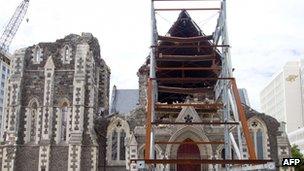
The historic cathedral was among the buildings ruined by the quake
After the quake struck, it was thought that people would start leaving New Zealand's second-largest city.
According to Mr Parker, only 10,000 of the base population of 500,000 have actually left. He sees this as "the greatest vote of confidence".
The city is now recruiting thousands of skilled workers to fuel its NZ$30bn ($24.4bn) rebuilding effort.
The area is frequently hit by tremors, with major quakes striking the city in June and December last year.
Six months before the devastating quake, the region was shaken by a 7.1-magnitude quake, but that did not cause major destruction.
CLICKABLE
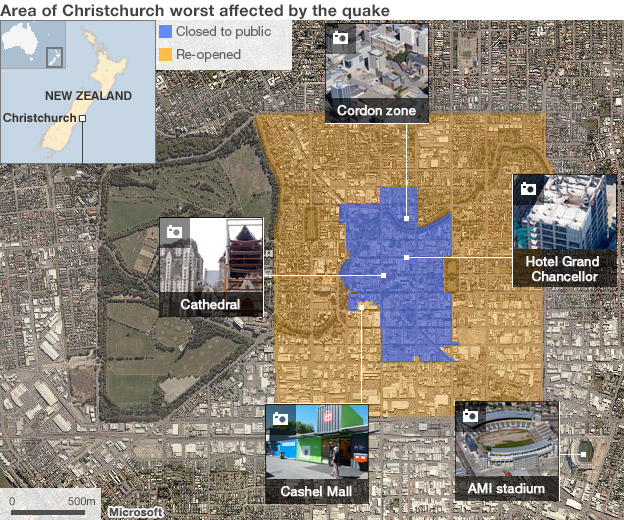
Cordon zone
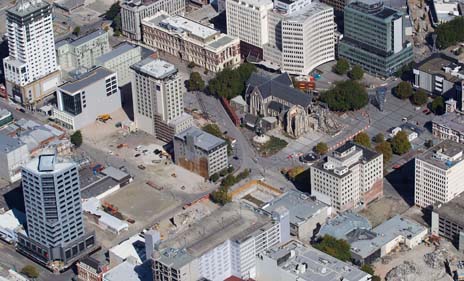 Canterbury Earthquake Recovery Authority has been working to clear and rebuild parts of the city since the February quake and a number of after-shocks that have followed. The area cordoned off to the public has been gradually reduced but it is estimated more than 60% of the historic buildings in central Christchurch were destroyed or severely damaged.
Canterbury Earthquake Recovery Authority has been working to clear and rebuild parts of the city since the February quake and a number of after-shocks that have followed. The area cordoned off to the public has been gradually reduced but it is estimated more than 60% of the historic buildings in central Christchurch were destroyed or severely damaged.
Christchurch Cathedral
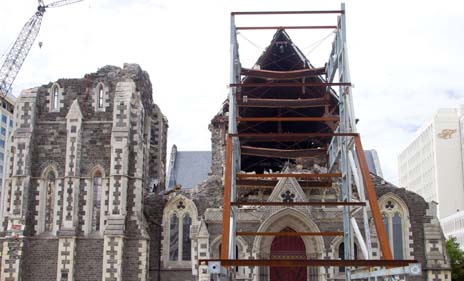 Badly damaged in the earthquake, the cathedral has since been made structurally safe so the bells and other artefacts could be removed. The cathedral was deconsecrated in November and parts of it will be demolished before it can be rebuilt at a cost of NZ$30m.
Badly damaged in the earthquake, the cathedral has since been made structurally safe so the bells and other artefacts could be removed. The cathedral was deconsecrated in November and parts of it will be demolished before it can be rebuilt at a cost of NZ$30m.
Hotel Grand Chancellor
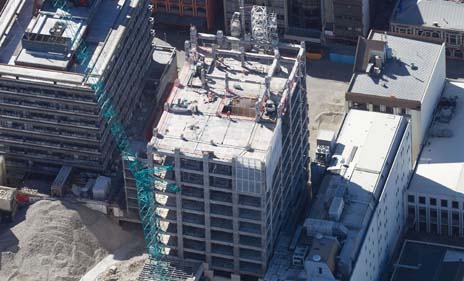 The 26-storey building suffered severe damage in the quake and is now being taken apart floor by floor. More than 800 other buildings in the city centre have been earmarked for demolition or partial demolition.
The 26-storey building suffered severe damage in the quake and is now being taken apart floor by floor. More than 800 other buildings in the city centre have been earmarked for demolition or partial demolition.
Cashel Mall
 The Cashel shopping centre was devastated by the quake. A new temporary mall of more than 20 stores built out of shipping containers, opened in October 2011.
The Cashel shopping centre was devastated by the quake. A new temporary mall of more than 20 stores built out of shipping containers, opened in October 2011.
AMI stadium
 The AMI stadium suffered severe earthquake damage and will not reopen this year. Engineers have recommended at least one stand should be demolished - they are still working out how best to repair other seating stands which dropped several centimetres in the quake. The pitch is being removed to a rugby league ground.
The AMI stadium suffered severe earthquake damage and will not reopen this year. Engineers have recommended at least one stand should be demolished - they are still working out how best to repair other seating stands which dropped several centimetres in the quake. The pitch is being removed to a rugby league ground.
- Published22 February 2012
- Published21 February 2012
- Published21 February 2012
- Published21 February 2012
- Published9 February 2012
- Published23 June 2011
- Published20 June 2011